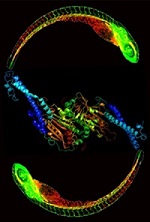Crystal Structure and Functional Analysis Identify Evolutionary Secret of SerRS in Vascular Development

|
Aminoacyl-tRNA synthetases are key enzymes in the fundamental process of
protein synthesis. They attach amino acids to transfer RNA (tRNA),
which, in turn, delivers the amino acids to the ribosome, the cellular
machinery for the production of protein amino acid chains. During evolution,
organisms added new domains to tRNA synthetases, which are believed to enable
additional functions beyond protein synthesis. Researchers from The Scripps
Research Institute, Florida State University and the University of Texas
Houston have established an essential role for an appended domain of tRNA
synthetase in organisms for the very first time. The study was published in
Nature Communications.
Using SSRL’s Beam Line 7-1, the scientists determined the crystal
structure of human seryl-tRNA synthetase (SerRS) at 2.9 Å resolution.
SerRS had previously been implied in the development of blood vessels and
circulatory systems of vertebrates. With the current study, the researchers
were able to link this role to the protein’s appended UNE-S domain.
The scientists identified a crucial nuclear localization signal (NLS)
sequence in UNE-S that directs SerRS to the cell’s nucleus. Disruption of
the NLS prevents SerRS from entering the nucleus and causes vascular defects.
Based on these findings, the researchers were also able to specifically alter a
vasculature-defective SerRS mutant, whose NLS was masked, and redirect it to
the nucleus. This second mutation removed the vascular defect in vivo
and established the critical role of UNE-S for nucleus-targeting by SerRS and,
hence, an organism’s vascular development.
Primary Citation
X. Xu, Y. Shi, H.-M. Zhang, E. C. Swindell, A. G. Marshall, M. Guo, S. Kishi, and X.-L. Yang, "Unique Domain Appended to Vertebrate tRNA Synthetase is Essential for Vascular Development", Nat. Commun. 3, 681 (2012); doi: 10.1038/ncomms1686.
Related Links
- Science Highlight – HTML / PDF
- SSRL Science Highlights Archive
- SSRL Beam Lines
Contact
Xiang-Lei Yang, The Scripps Research Institute (La Jolla, California)
